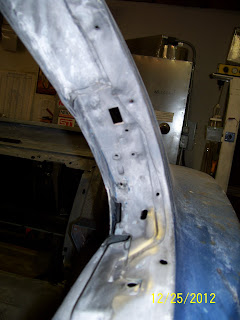The latest concentration has been treating the light surface
rust in all the critical areas in any way I could approach. At first, I ventured to use my trusty
chelation process, but quickly found that I had reached a practical limit in its
application in consideration of the limits of my space and the difficulties in
the recovery of the chelant in such complex structures as those in the rear of
a Mustang. As such, I resorted to the
old tried and true wire brush and elbow grease method for the majority of the job. Of particular interest was cleaning up and
prepping the areas surrounding the door openings and the roof drip rails.
As I have mentioned in several posts in the past, I have
learned that it is critical to remove every bit of factory seam sealer that can
be removed in the process of a proper restoration. This is especially true of the roof drip
rails and window surrounds on any classic Mustang. In keeping with that, I again turned to acetone
to soften the compound and using scrapers and wire brushes of various
configurations to remove it from all of the door opening surfaces. Next, I dove into the task of cleaning up the
inner door openings, rocker sills and B-pillar posts. For the most part, the bulk of this work involved
removing the original paint and primer and then treating the slightly rusted
spots with phosphoric acid-based “prep & etch” solution to remove it and
protect the bare metal until it was time to apply primer. B-O-R-I-N-G and time-intensive work, but the
results were very good and I managed to fit all of it in in spite of the
requisite Christmas preparations and associated activities that demand as much
time as any resto work ever did!
So, with the door openings in good shape, I decided to
tackle a few repairs/modifications on the rear bodywork. One was by necessity and the other by
choice. Of priority was the need to
repair to cracks about 1¼” long that radiated from the top corners of the trunk
lid opening out into the quarter panels.
This is a common crack area in Mustangs, especially in car that have
been extensively drag raced without added structural reinforcement like a roll
cage or subframe connectors.
These repairs are pretty simple in concept, but a bit tricky
in that they often traverse many body character lines and welding them up takes
a pretty fine tune on the welder to ensure minimal distortion and weld bead
size.
The first order of business is to stop the crack’s
propagation by drilling a small hole just beyond its end. In my case, I used a sharp 1/8” bit for the
job and this did the job perfectly.
Next, I tack the inboard origin of the crack to lock down
that end and to keep the panels as stable as possible. At this point, the crack is isolated on both
ends and can now be repaired. Using my
trust Dremel tool, I used a thin cutoff blade and carefully cut directly along
the crack to provide a gap that would allow full weld penetration without
buckling. This gap only needs to be
about .030-.050” wide max when using .023” MIG wire and can be as tight as
.015-.020” with TIG.
With the prep work complete, the crack was welded up using a
step-stitch method with the MIG set at a slightly hotter range than recommended
to allow a quick burst of weld that would lay flat and fill well. After each stitch, I would cool the area with
a blast of air and repeat the process until the gap was fully welded. This technique is a little different than
welding in patch panels as it is of much shorter duration and is essentially
stacking a series of small spot welds in a row until a complete bead is
formed. The truth is, I often resort to
this method when installing patches as it helps keep weld distortion to a
minimum, at the expense of considerable increase in repair time. But HEY, this is a hobby right? What’s a little extra time?????
With the cracks fully welded up, a few minutes with the
sanding disc in the angle grinder was all that was required to get the surface
back to smooth with no evidence the cracks were ever there. Now, not being one to leave well enough
alone, I took the opportunity to do one more small tweak to the body that I
have been planning since day one. The
fact that it fires yet another shot across the bow of the purist elite makes it
all the more enjoyable.
Since I was working in the “neighborhood”, I took the
opportunity to fully weld up the seams between the upper trunk panel and the quarters. As long as I can remember, my eye has been
drawn to this area of 69 and 70 Mustangs as one that always seemed unfinished
at worst and inconsistent at best. In
fact, I am not sure I have ever seen these seams look the same way twice and it
peeves me to no end. Well not on MY car
it won’t! So, after a quick wave of the
magic smoke-wand, they are no more!
And that is pretty much a wrap for now. I apologize it wasn’t a bit more of an
adventure, but those days are coming soon.
But for now, the tedium will continue for a while longer. Until next time! |
| As fortune would have it, the passenger side rocker sill was also in excellent shape after clean-up and etching. |
 |
| Although a crap picture, the quarter glass surrounds cleaned up well and are completely solid. |
 |
| Though a slight bit of finish work is still left, this shot shows the gaps filled and the crack repaired. |


























































